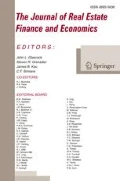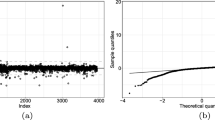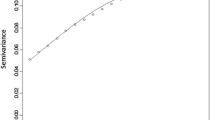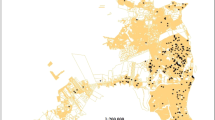Abstract
OLS regression has typically been used in housing research to determine the relationship of a particular housing characteristic with selling price. Results differ across studies, not only in terms of size of OLS coefficients and statistical significance, but sometimes in direction of effect. This study suggests that some of the observed variation in the estimated prices of housing characteristics may reflect the fact that characteristics are not priced the same across a given distribution of house prices. To examine this issue, this study uses quantile regression, with and without accounting for spatial autocorrecation, to identify the coefficients of a large set of diverse variables across different quantiles. The results show that purchasers of higher-priced homes value certain housing characteristics such as square footage and the number of bathrooms differently from buyers of lower-priced homes. Other variables such as age are also shown to vary across the distribution of house prices.
Similar content being viewed by others
Notes
See Kirman (1992) for a scathing critique of the representative agent paradigm.
The articles in Durlauf and Young (2001) provide a good idea of the social dynamics that may evolve and why they may evolve.
The quantile regressions employ the “sqreg” command in Stata for seed 1001.
The Matlab program xy2cont.m of J.LeSage’s Econometrics Toolbox is employed, which is an adaptation of the Matlab program fdelw2.m of Kelley Pace’s Spatial Statistics Toolbox 2.0.
If X identifies the data matrix, then the spatial lags of the regressors are computed as WX, where W is the spatial weight matrix used for the construction of the spatial lag of the dependent variable.
The bootstrap is based on 500 replications.
The data used are similar to the data used in Zietz and Newsome (2002).
Variance inflation factors (VIF) are calculated for all variables. The maximum VIF is 2.51, the mean VIF is 1.54. This does not suggest that the regressions suffer from multicollinearity.
The p values of the OLS estimates are based on an estimate of the variance–covariance matrix that is robust to heteroskedasticity.
The variable year can be converted to measure the age of a house by simply subtracting the value of year from 2000 for a given observation. This linear transformation does not affect the coefficients of any variable other than year or age and the constant.
References
Anselin, L. (2001). Spatial econometrics. In B. H. Baltagi (Ed.), A companion to theoretical econometrics (pp. 310–330). Malden, MA and Oxford: Blackwell.
Bartik, T. J. (1987). The estimation of demand parameters in hedonic price models. Journal of Political Economy, 95, 81–88.
Durlauf, S. N., & Young, H. P. (Eds.) (2001). Social Dynamics. Cambridge, MA: MIT.
Epple, D. (1987). Hedonic prices and implicit markets: estimating demand and supply functions for differentiated products. Journal of Political Economy, 95, 59–80.
Gould, W. W. (1992). Quantile regression with bootstrapped standard errors. Stata Technical Bulletin, 9, 19–21.
Gould, W. W. (1997). Interquantile and simultaneous-quantile regression. Stata Technical Bulletin, 38, 14–22.
Greene, W. H. (2000). Econometric Analysis, 4th ed., Prentice Hall, Saddle River, N.J.
Heckman, J. J. (1979). Sample selection bias as a specification error. Econometrica, 47, 153–161.
Kim, T.-H., & Muller, C. (2004). Two-stage quantile regression when the first stage is based on quantile regression. Econometrics Journal, 7, 218–231.
Kirman, A. P. (1992). Whom or what does the representative individual represent? Journal of Economic Perspectives, 6, 117–136.
Koenker, R., & Bassett, G. (1978). Regression quantiles. Econometrica, 46, 33–50.
Koenker, R., & Hallock, K. F. (2001). Quantile regression. Journal of Economic Perspectives, 15, 143–156.
Malpezzi, S. (2003). Hedonic pricing models: A selective and applied review. In T. O. Sullivan & K. Gibbs (Eds.), Housing economics and public policy: Essays in honor of Duncan Maclennan. Oxford, UK: Blackwell.
Malpezzi, S., Ozanne, L., & Thibodeau, T. (1980). Characteristic prices of housing in fifty-nine metropolitan areas, Research Report. Washington, DC: The Urban Institute, December.
Newsome, B., & Zietz, J. (1992). Adjusting comparable sales using MRA—The need for segmentation. Appraisal Journal, 60, 129–135.
Rogers, W. H. (1993). Calculation of quantile regression standard errors. Stata Technical Bulletin, 13, 18–19.
Rosen, S. M. (1974). Hedonic prices and implicit markets: Product differentiation in pure competition. Journal of Political Economy, 82, 34–55.
Sirmans, G. S., Macpherson, D. A., & Zietz, E. N. (2005). The composition of hedonic pricing models. Journal of Real Estate Literature, 13 (1),3–46.
Zietz, J., & Newsome, B. (2002). Agency representation and the sale price of houses. Journal of Real Estate Research, 24, 165–191.
Author information
Authors and Affiliations
Corresponding author
Rights and permissions
About this article
Cite this article
Zietz, J., Zietz, E.N. & Sirmans, G.S. Determinants of House Prices: A Quantile Regression Approach. J Real Estate Finance Econ 37, 317–333 (2008). https://doi.org/10.1007/s11146-007-9053-7
Published:
Issue Date:
DOI: https://doi.org/10.1007/s11146-007-9053-7




